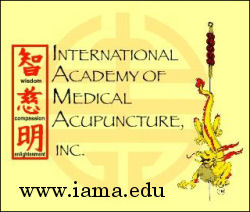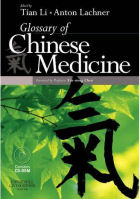Acupuncture & TCM Articles

Acupuncture Articles
by John A. Amaro L.Ac., Dipl.Ac.(NCCAOM), DC
 Dr. Amaro is an internationally known author, lecturer and practitioner beginning his practice of Acupuncture and Chiropractic in 1971. He has led 13 diplomatic Acupuncture study tours of The People's Republic of China escorting more than 500 doctors and practitioners. He has personally studied Acupuncture in nine separate Asian nations. Dr. Amaro is an internationally known author, lecturer and practitioner beginning his practice of Acupuncture and Chiropractic in 1971. He has led 13 diplomatic Acupuncture study tours of The People's Republic of China escorting more than 500 doctors and practitioners. He has personally studied Acupuncture in nine separate Asian nations.
He has received Certification in Acupuncture through the Columbia Institute of Chiropractic in 1973. This was one of the first Acupuncture postgraduate education programs for physicians in North America commencing in 1972.
He has been certified by the Waseda Acupuncture College in Tokyo, Japan in 1974 and graduated from the Chinese Medical Institute, Kowloon, China in 1976. He had previously taken postgraduate studies at the Tai Chung Medical School Taipei, China 1973.
The most Important terms used in:
TRADITIONAL CHINESE MEDICINE
John A. Amaro L.Ac., Dipl.Ac.(NCCAOM), DC
Throughout Traditional Chinese Medicine (TCM) there are a number of terms which comprise the understanding of both diagnosis and treatment in acupuncture and herbal therapy. Even though in Contemporary Chinese Medicine (CCM) it is possible and plausible to attain clinical response equal to the TCM practitioner, it is nonetheless important to have not only an awareness but an understanding of the following terms which make up the practice of Traditional Chinese Medicine. This is not intended as a full list nor are the explanations offered complete as to detail, however, it is a synopsis of some of the most important terms used in TCM. Save this article for future reference you will find it to be a very valuable resource.
· BLOOD DEFICIENCY: Clinical indications include pale complexion, pale lips, pale tongue, a thready pulse, blurring of vision, insomnia, numbness of hands and feet, vertigo and poor memory.
· BLOOD STAGNATION: Seen in fixed stabbing pain, petechial hemorrhage, purple lips and nails, purple bruises on skin, purple tongue and wiry, knotted or choppy pulse.
· COLD: Created by cold pathogens (cold weather or conditions), manifests in diminished vital function marked by intolerance to cold weather, fondness for warmth, loose bowels, pale tongue with white coating and slow pulse.
Glossary of
Chinese Medicine
 
· COLD IN THE MIDDLE BURNER: Refers generally to cold in the spleen and stomach or earth element. Manifests by cold and pain over the stomach, pain over abdomen, anorexia, belching, abdominal fullness, bloating, vomiting thin fluid, cold limbs and lassitude.
· DAMPNESS: Caused by external damp pathogenic factors or internally by imbalance of the spleen or kidney in promoting water circulation and distribution. Manifests by heaviness in the limbs, fullness in the chest, headache as if a belt were cinched around the head, joint pain and swelling, abdominal distention, diarrhea, edema of lower limbs, sallow face and possibly additional symptoms.
· DAMP HEAT: A combination of both dampness and heat manifested by nausea, vomiting, heaviness of the body and limbs, jaundice, anal burning, abdominal burning pain and edema, urinary dribbling, burning pain in the urethra, frequent and urgency in urination, lassitude, fullness in the chest, anorexia, bitter taste and stickiness in the mouth, loose stools with blood or mucus, yellow or foul smelling vaginal discharge, turbid deep yellow urine, red tongue with sticky yellow coating, rapid and slippery pulse.
· DEFICIENCY: Deficiency of vital energy and lowered body resistance. Primary symptoms include listlessness, lassitude, emaciation, shortness of breath, pallor, poor memory, spontaneous or night sweating, nocturnal enuresis, dry tongue with little or no coating, pulse weak and thready.
· DEFICIENCY FIRE OR HEAT: Created by a deficiency of Yin. Manifested by constipation, night sweats, dry mouth, low grade fever, insomnia with mental restlessness, red tongue with little coating, pulse rapid, thready and empty.
· DRYNESS: One of the pathogenic factors which primarily prevails in Autumn or in dry climates. Creates consumption of body fluids, with red eyes, dry nose and throat, dry cough, dry skin, constipation, reduced urination.
· FIRE: A severe form of heat, manifested by high fever, restlessness, insomnia, mania delirium, thirst, sweating, oral ulcers, swollen and painful gums, headache, red and congestion of eyes.
· FOOD STAGNATION: Manifests by stomach pain, distention of abdomen, loss of appetite, foul flatulence, acid regurgitation, vomiting. Tongue shows a thick, sticky coating.
· HEART BLOOD DEFICIENCY: Symptoms include pallor, palpitation, insomnia, forgetfullnes, giddiness and a fine, weak, irregular pulse.
· HEART QI DEFICIENCY: Symptoms include heart palpitations, shortness of breath on exertion, spontaneous sweating, a fine, weak, or irregular pulse.
· HEART YIN DEFICIENCY: Manifests by low grade fever, night sweats, flushed cheeks, thirst, mental irritability and a fine rapid pulse.
· HEAT: Created by external pathogenic heat manifested by flushed face, fever, thirst, craving for cold drink, constipation, red tongue with yellow coating and rapid pulse.
· HEAT IN THE BLOOD: Manifested by restlessness, fever, skin eruptions, oral ulcers, itching, excessive menstrual bleeding, pettechia, dry mouth, red tongue and rapid pulse.
· HEAT TOXIN: Relates to toxic heat generated by bacterial or viral infections.
· JING: Refers to the energy derived from the inherited constitution as well as that derived from food, water, and air. It is contained primarily within the kidney meridian network and is the basis for growth, reproduction and development. It is the source of constitutional strength. Deficiency of Jing results in numerous symptoms among them, infertility, habitual miscarriage, poor sexual function, impotence, falling hair, premature graying, weakness of legs, tinnitus, poor concentration and memory, vertigo, lowered body resistance and chronic allergies. Also, stunted growth and poor bone development in the early years.
· KIDNEY YANG DEFICIENCY: Symptoms include cold limbs, pallor, soreness and weakness of the lumbar spine, soreness and weakness in the knees, impotence, infertility, vertigo, tinnitus, nocturnal emission, pale tongue with white coating and a deep weak pulse.
· KIDNEY YIN DEFICIENCY: Manifest by low back pain, weak knees, general weakness, vertigo tinnitus, thirst, flushed cheeks, irritability, afternoon fever, night sweats nocturnal emission, yellow urine, constipation, red tongue with little coating, and a thready rapid pulse.
· LIVER BLOOD DEFICIENCY: Manifests by vertigo, mental irritability, insomnia, absent or scanty menstruation, prolonged menstrual cycle, dry eyes, blurring of vision, muscle spasms, pale tongue and/or lips.
· LIVER FIRE: Symptoms include vertigo, headache, flushed face, red eyes, bitter taste in the mouth, mental irritability, anger outbursts. In severe cases may also include, nosebleed, blood in the urine, hemoptysis, tongue is scarlet red on tip and sides with yellow coating with wiry and rapid pulse.
· LIVER HEAT: As Liver Fire but not as severe.
· LIVER QI STAGNATION: Symptoms include easily angered, vertigo, abdominal and hypochondriac pain and distention, fullness in chest, sighing, breast distention, belching, anorexia, nausea, sensation of something in throat, menstrual disorders.
· LIVER WIND: As a result of generally Liver fire or Deficient blood, symptoms include, vertigo, convulsions, tremors, spasms and numbness.
· LIVER YANG RISING: Symptoms include anger, vertigo, tinnitus, flushed face, red eyes, insomnia with dream disturbed sleep, poor memory, headache with distended sensation in head, red tongue and a tight rapid pulse.
· LIVER YIN DEFICIENCY: Manifests by vertigo, headache, tinnitus, blurred vision, dry eyes, insomnia, night sweats, hot palms and soles, thirst, dry throat, tongue is reddened with little coating and a thready taut pulse.
· LUNG HEAT: Manifested by cough with thick or yellow phlegm, pain in the chest and dyspnea.
· LUNG YIN DEFICIENCY: Symptoms are dry or blood tinged sputum, cough with small sticky sputum, dryness of the mouth and throat, afternoon fever, night sweats, hot palms and soles, red tongue with little coating and a thready and rapid pulse.
· PAINFUL OBSTRUCTION: Obstruction of vital energy and blood which brings on pain specifically arthritic due to wind, cold, and dampness blocking the meridians of the limbs.
· PATHOGENIC FACTORS: The basic philosophic cause of disease. Pathogenic factors include Wind, Cold, Dampness, Heat, Dryness and Fire. These are generally of external origin such as climatic changes by invasion of for example, Wind/Cold or it can by internally generated such as Liver Wind. However, when discussing Pathogenic Factors it is usually assumed we are discussing external climatic conditions.
· PHLEGM: Results from an accumulation of bodily fluids due to a dysfunction of the lung, spleen and kidney with impairment of water metabolism. Clinical manifestations are numerous to include cough with profuse sputum, asthmatic breathing, fullness in the chest, palpitations, manic depressive disorders, lymph node swelling, nodules under the skin, dizziness, blurred vision, sensation of something in throat, edema, general body aching and heaviness, nausea, vomiting of sticky fluid, abdominal discomfort.
· PHLEGM DAMP: Chronic phlegm which is clear or white, affecting primarily the lungs, digestive or reproductive system.
· PHLEGM HEAT: Affecting primarily the lung or stomach. Includes symptoms of yellow sticky phlegm, barking cough with profuse yellow or green sputum, fullness in the chest, asthma, dry mouth and lips restlessness with red tongue with a sticky yellow coating and rapid, slippery pulse.
· QI (CHI): The vital energy which flows over the acupuncture meridians. It is responsible for the energetics to all organs, cells, tissues and structures in the body . Commonly referred to as "LIFE".
· QI DEFICIENCY: Symptoms include general weakness, lethargy, shortness of breath, weak voice, spontaneous sweating, anorexia, abdominal distention, loose stools, frequent urination, palpitations and an empty pulse.
· QI STAGNATION: Qi normally mobilizes around the body, when Chi energy stagnates, it creates dysfunction and pain. Trauma, surgical scars can create stagnation of Chi.
· SHEN: Shen is translated as "Spirit". It refers to the mind, consciousness, the force of the personality and the connection to the spiritual aspects of humanness. When Shen is disturbed or unstable, it produces insomnia, unclear or muddled thinking, poor memory, restlessness, hysteria, incoherent speech, delirium, manic depression, excessive dreaming, melancholy etc.
· SHAO YANG DISORDER: Is an intermediate stage of an illness where the pathogenic factors remain between the exterior and the interior.
· SPLEEN DAMPNESS: Manifests by anorexia, stickiness of the mouth, loss of sense of taste, nausea, fullness in the chest and abdomen, feeling of heaviness, loose stool, headache as if a band were around head, tongue has sticky coating with a slippery pulse. Often the basis for phlegm congestion in the lungs.
· SPLEEN QI DEFICIENCY: Manifests by emaciation, lassitude, aphasia, anorexia, abdominal distention, loose stool, pale tongue with thin white coating. Pulse is empty, weak or thready.
· SPLEEN YANG DEFICIENCY: Symptoms are pallor, cold limbs, poor appetite, abdominal distention which is worse following eating, dull abdominal pain which improves with warmth and pressure, loose stools. Tongue is pale with a white coating. Pulse is deep and slow.
· STOMACH PHLEGM: Symptoms include nausea, vomiting, abdominal fullness with sticky tongue and slippery pulse.
· STOMACH QI DEFICIENCY: Manifests by uncomfortable feeling in the stomach, anorexia, lack of taste, loose stool, lassitude especially in the morning, weak limbs. Tongue is pale with a weak pulse especially over the ST and SP.
· WEI QI: Refers to "Defensive Energy" which protects the body from invasion by External Pathogenic Factors.

· WIND: One of the six pathogenic factors. External wind is usually combined with one of the other pathogenic factors such as cold, heat, dampness or dryness which depend on wind to invade the body. Symptoms of external wind include headache, stiff neck, nasal obstruction, sneezing, itching or pain in the throat, facial puffiness, aversion to wind, joint pains with a superficial pulse. Internal or exogenous wind may be caused by deficient blood or hyperactive liver yang. Its symptoms include headache, stiff neck, irritability, vertigo, fainting, high fever, delirium, convulsions, tremors, tics, blurred vision, numbness, facial paralysis, wandering pains.
· WIND-COLD: Symptoms include aversion to cold, shivering, sneezing, cough, runny nose with watery or white discharge, slight fever, neck pain and stiffness, tight and superficial pulse normal appearing tongue.
· WIND - HEAT: Manifests by similar symptoms as wind cold except with symptoms of heat such as fever, yellow mucus, sore throat, swollen tonsils, thirst, sweating. Pulse is floating and rapid. Tongue is red on the tip and sides with thin, white, or yellow coating.
· WIND - DAMP: Symptoms include: itchy skin, rashes, hives, fever, aversion to cold, sweating, neck pain and stiffness, body aches and heaviness, swollen joints with a superficial and slippery pulse.
|
